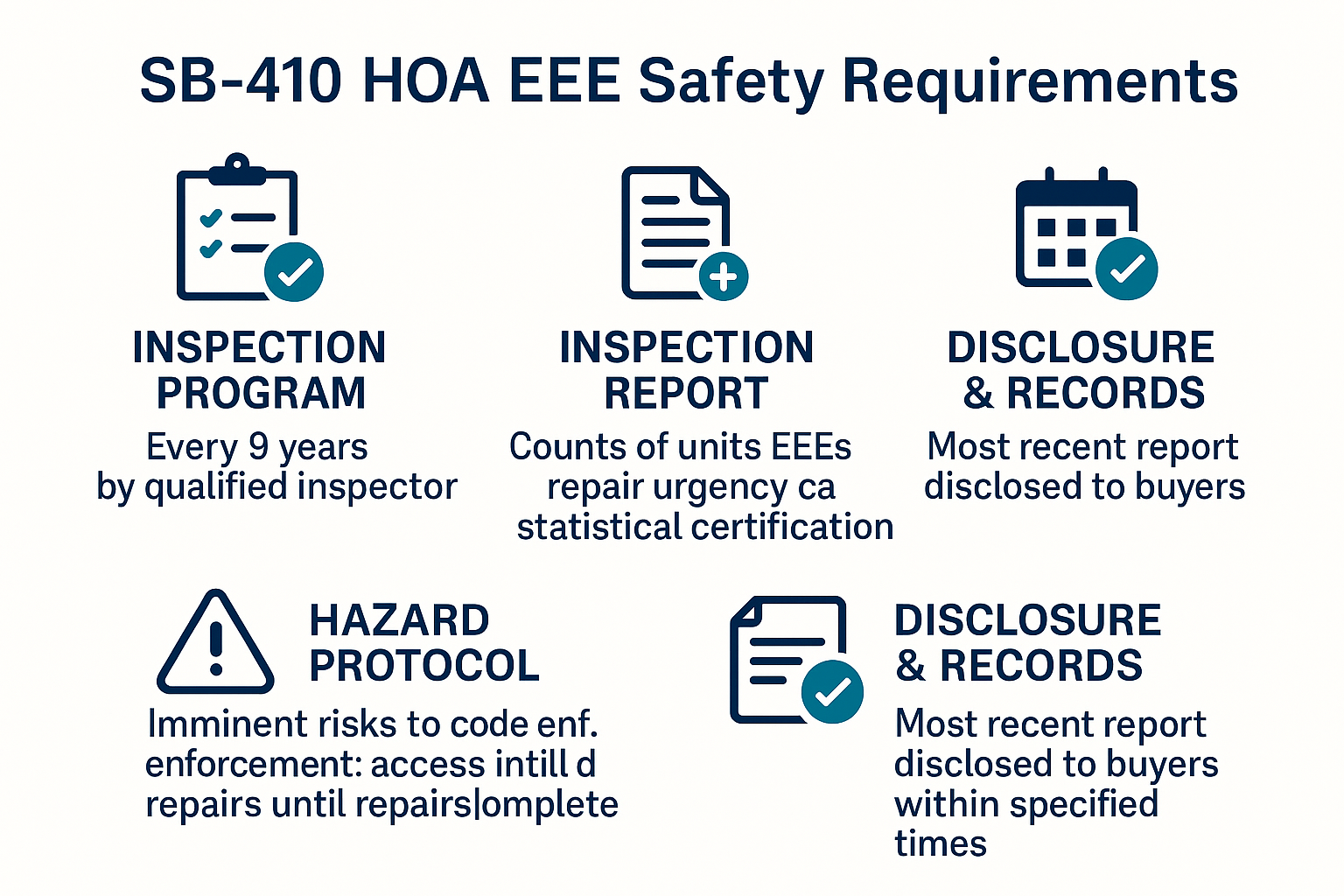Summary:
California’s condominium and multifamily housing communities rely on shared structural components—such as balconies, decks, and elevated walkways—that, if neglected, can pose severe safety risks. Following tragedies like the 2015 Berkeley balcony collapse, the state enacted SB 326 and SB 721 to mandate periodic inspections. Senate Bill 410 (SB‑410), signed into Law in 2025, builds on these reforms by expanding inspection, disclosure, and recordkeeping requirements under the Davis-Stirling Common Interest Development Act.
Background: Why SB‑410 Was Needed
- In 2015, a balcony failure killed six people and injured seven others, exposing gaps in inspection standards.
- SB‑326 (2019) required visual inspections of exterior elevated elements (EEEs) every nine years for condominiums.
- SB‑721 imposed similar rules for multifamily rentals.
- SB‑410 closes loopholes by:
- Enhancing inspection report detail.
- Mandating disclosure to prospective buyers.
- Expanding association recordkeeping obligations.
✅ Comparison Table: Pre‑SB‑410 vs Post‑SB‑410 Requirements
|
Requirement |
Pre‑SB‑410 |
Post‑SB‑410 |
|
Inspection Frequency |
Every 9 years (SB‑326) |
Every 9 years (unchanged) |
|
Inspection Report Detail |
Basic findings |
Must include unit counts, EEE counts, repair urgency categories, and statistical sampling certification |
|
Disclosure in Sales |
Not required |
The latest EEE inspection report must be provided to buyers |
|
Recordkeeping Access |
General Davis-Stirling timelines |
10 business days (current year), 30 days (prior 2 years) |
Key Provisions of SB‑410: Crucial Measures for Building Safety and Consumer Protection
1. Expanded Inspection Requirements
- Applies to buildings with three or more attached multifamily dwelling units (clarified from prior language).
- Associations must:
- Conduct visual inspections every nine years of EEEs under their maintenance responsibility.
- Use qualified inspectors (licensed architect, structural engineer, or certified contractor).
- Inspection report must include:
- Date of inspection.
- Total number of units and units with EEEs.
- Total EEEs inspected and categorized by repair urgency:
- Within 1 year
- 1–4 years
- 4–9 years
- After 9 years
- Certification of statistically significant sample (95% confidence, ≤5% margin of error).
2. Mandatory Disclosure in Real Estate Transactions
- Owners selling a separate interest must provide:
- Most recent EEE inspection report to prospective buyers.
- Civil Code §§4525 and 4528 updated to include this requirement in disclosure forms.
- Goal: Improve transparency for buyers and lenders regarding structural safety and future repair costs.
3. Association Recordkeeping and Access
- Associations must maintain:
- All inspection reports and related documents.
- Expanded set of records for property purchases.
- Access timelines:
- 10 business days for current fiscal year records.
- 30 calendar days for the prior two years.
- Immediate hazards:
- Inspectors must notify the association and local code enforcement within 15 days.
- Associations must restrict access to unsafe elements until repairs are approved.
4. Uniform Rating System
- Creates standardized categories for repair timelines (e.g., 0–1 years, 2–4 years, 5–9 years, 9+ years).
- Helps HOAs plan reserves and clearly communicate future obligations.
Impact on HOAs and Owners
- HOAs: Increased administrative duties, cost for inspections, and compliance with disclosure timelines.
- Owners: Greater transparency but potentially higher fees for inspection compliance.
- Buyers: Improved ability to assess structural safety and financial risk before purchase.
✅ Compliance Checklist for SB‑410
Before 1 January 2026:
- Schedule an EEE inspection if it has not been done within the last nine years.
- Ensure report includes:
- Unit counts, EEE counts, repair categories, and statistical sampling certification.
- Update disclosure packets for sales to include the latest inspection report.
- Maintain records and meet access timelines.
- Implement safety protocols for hazardous findings.
Bottom Line
SB 410: A Law with a Clear Mission SB‑410 strengthens California’s commitment to building safety and consumer protection in common interest developments. By requiring detailed inspections, transparent disclosures, and robust recordkeeping, the Law aims to prevent structural failures and enhance trust in the housing market. This is the bottom line of SB 410.
